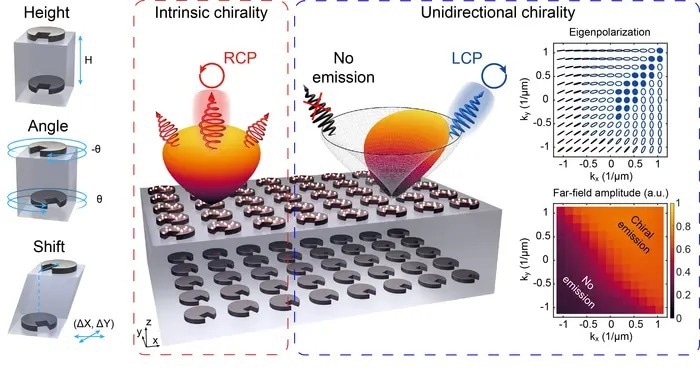Associate Professor Wu Lin and her colleagues from the Singapore University of Technology and Design have created a spiral ladder-inspired instrument that enables precise control over light polarization and direction. The study was published in Nature Communications.
 Schematic of the twisted bi-layer metasurface with two design configurations: aligned discs (intrinsic chirality) and displaced discs (unidirectional chirality). Detailed maps of eigenpolarization and far-field amplitude are shown for the design exhibiting unidirectional chirality. Key design parameters include interlayer distance, twist angle, and lateral displacement. Image Credit: SUTD
Schematic of the twisted bi-layer metasurface with two design configurations: aligned discs (intrinsic chirality) and displaced discs (unidirectional chirality). Detailed maps of eigenpolarization and far-field amplitude are shown for the design exhibiting unidirectional chirality. Key design parameters include interlayer distance, twist angle, and lateral displacement. Image Credit: SUTD
Photonics is the study of how light waves, known as photons, are generated, detected, and manipulated. Polarization is an interesting feature of light, described by its electric and magnetic forces oscillating in any direction perpendicular to the propagation direction. This oscillation is not limited to a single plane either. Circular polarization occurs when light waves have electric fields that spiral in the direction of transmission.
Although regulating these circularly polarized waves is difficult, they have applications in optical communications, quantum computing, and biological and chemical sensing.
When we generate circularly polarized light, we want to make sure that it is directed at a specific angle for us to collect and efficiently use it.
Wu Lin, Associate Professor, Singapore University of Technology and Design
Quantum dots, semiconductor nanocrystals exhibiting quantum mechanical properties due to their small size (2–10 nanometers), are the best compact light emitters. Directional emission or circular polarization is made possible when the light is placed adjacent to nanostructures.
Otherwise, the light is poorly polarized and travels in all directions. However, it has never been possible to regulate both direction and polarization at the same time. To close this gap, Associate Prof. Wu and her colleagues published a study titled “Unidirectional chiral emission via twisted bi-layer metasurfaces.”
In essence, the team had to deal with a complex problem. They had to use a carefully designed resonance of the structure to regulate the polarization of the light and the direction of the emitted beam. Furthermore, a circularly polarized wave cannot have its mirror image superimposed on top of it since it is chiral. The structure’s mirror symmetries must be violated to produce chiral waves, which gives them peculiar designs.
Under the guidance of Associate Prof. Wu, Dmitrii Gromyko, a PhD student at SUTD-NUS and the study’s first co-author, came up with the answer. Dmitrii initially created the concept of twisted bilayer metasurfaces, consisting of two layers of periodically ordered discs with notches carved at particular angles, after being inspired by a spiral staircase and a double-headed drum.
Associate Prof. Wu and the study team improved this creative strategy even more. This structure’s bilayer design is the main factor contributing to its success. The metasurface offers adaptability and synergy since both layers can be separately modified before coupling.
While the electric fields of our waves are smooth and continuous in space, they can be generated by just two layers of discs which resemble a two-step spiral ladder. Just climbing two steps of this ladder is enough for you to know if you are taking a clockwise or counterclockwise path. In the case of photonic nanostructures, you just have to choose the right size for the steps of your ladder.
Dmitrii Gromyko, Study Co-First Author and PhD Student, Singapore University of Technology and Design
According to the drum analogy, the bottom drumhead’s vibrations are coupled with the top drumhead's oscillations when sound strikes it. The nanostructure is the same, except that it is asymmetric due to the notches in its discs. Due to this asymmetry, the notched discs in each layer can be rotated to adjust the polarization of the emitted waves.
With this design, the team could regulate three factors critical for precise emission control: the distance between the two layers, the angle between the notches in the top and bottom discs, and the lateral movement of the top discs’ centers relative to the bottom discs. However, building such a nanostructure was a massive undertaking.
Prof. Wu added, “This is a real challenge because you have to vertically align the two layers with a precision of 10 nanometers. I’m proud that we have such capabilities in Singapore, as our colleagues from the Agency for Science, Technology and Research and the National University of Singapore performed the fabrication and measurement steps.”
A team directed by Associate Professor Zhaogang Dong, who just joined SUTD's Science, Mathematics, and Technology cluster, carried out the core experimental work.
Creating these bilayer metasurfaces has numerous advantages. Theoretically, it contributes to understanding resonances in multi-layer systems, design methods, and fabrication technologies. It allows for the asymmetrical directional emission of waves with specific qualities. The nanostructure can then act as efficient emitters, routers, or grating couplers for circularly polarized waves, among other things.
The team’s next step is to combine their bilayer design with nano-electro-mechanical systems to create reconfigurable chiral metasurface systems capable of actively manipulating light emission angle, wavelength, and polarization.
This study demonstrates SUTD’s principle of intersecting design and technology, paving the way for the development of ultra-compact devices with specialized qualities that fit the needs of modern science and technology.
Wu concluded, “There is a myriad of challenges and practical problems waiting to be resolved with a smart design. It is all about designing new solutions and advancing the current technology.”
Journal Reference:
Gromyko, D. et. al. (2024) Unidirectional Chiral Emission via Twisted Bi-layer Metasurfaces. Nature Communications. doi.org/10.1038/s41467-024-54262-6